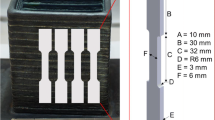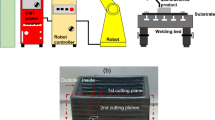Abstract
The paper is aimed to study the functional properties in the layered NiTi sample produced by wire arc additive manufacturing (WAAM). The experimental studies were carried out using two types of samples: including the Ti–rich and Ni-rich layers or including Ni-rich layers only. The obtained results showed that the existence of the Ti–rich NiTi layer affected the two-way shape memory effect, which was two times higher than the sample including the Ni-rich NiTi layers only. This was due to the additional internal stress formed during preliminary deformation on the border between the Ti–rich and Ni-rich NiTi layers. It was found that the existence of the Ti–rich NiTi layer suppressed the initiation of superelastic response because the stress-induced martensite remained stable on unloading. It was observed that excluding the Ti–rich NiTi layer from the deformation allowed to reveal the superelasticity effect. It was also noticed that the value of the maximum recoverable strain did not exceed 4%, which was 2–2.5 times less than in the NiTi samples produced by conventional technologies. It was assumed that a small recoverable stain was caused by the texture and a small strain up to failure.











Similar content being viewed by others
References
Otsuka K, Ren X (2005) Physical metallurgy of Ti–Ni-based shape memory alloys. Progress Mater Sci 50:511–678
Razov AI (2004) Application of titanium nickelide-based alloys in engineering. Phys Met Metallogr 97:97–126
Jani JM, Leary M, Subic A, Gibson MA (2014) A review of shape memory alloy research, applications and opportunities. Mater Des 56:1078–1113
Van Humbeeck J (1999) Non-medical applications of shape memory alloys. Mater Sci Eng A 273–275:134–148
Petrini L, Migliavacca F (2011) Biomedical application of shape memory alloys. J Metall. https://doi.org/10.1155/2011/501483
Liu J, Xu Y, Ge Y, Hou Z, Chen S (2020) Wire and arc additive manufacturing of metal components: a review of recent research developments. Int J Adv Manuf Tech 111:149–198
Wu B, Pan Z, Ding D, Li H, Xu J, Norrish J (2018) A review of the wire arc additive manufacturing of metals: properties, defects and quality improvement. J Manuf Proces 35:127–139
Elahinia M, Moghaddam NS, Andani MT, Amerinatanzi A, Bimber BA, Hamilton RF (2016) Fabrication of NiTi through additive manufacturing: a review. Progress Mater Sci 83:630–663
Walker JM, Haberland C, Andani MT, Karaca HE, Dean D, Elahinia M (2016) Process development and characterization of additively manufactured nickel–titanium shape memory parts. J Intel Mater Syst Struct 27:2653–2660
Wang J, Pan Z, Yang G, Han J, Chen X, Li H (2019) Location dependence of microstructure, phase transformation temperature and mechanical properties on Ni-rich NiTi alloy fabricated by wire arc additive manufacturing. Mater Sci Eng A 749:218–222
Zeng Z, Cong BQ, Oliveira JP, Ke WC, Schell N, Peng B, Qi ZW, Ge FG, Zhang W, Ao SS (2020) Wire and arc additive manufacturing of a Ni-rich NiTi shape memory alloy: microstructure and mechanical properties. Additive Manuf 32:101051
Resnina N, Palani IA, Liulchak P, Belyaev S, Mani Prabu SS, Jayachandran S, Kalgano VV (2020) The structure of 3D frame-bridge NiTi sample deposited to the low carbon steel substrate by wire arc additive manufacturing. Lett Mater 10:496–500
Resnina N, Palani IA, Belyaev S, Mani Prabu SS, Liulchak P, Karaseva U, Manikandan M, Jayachandran S, Bryukhanova V, Anshu S, Bikbaev R (2021) Structure, martensitic transformations and mechanical behaviour of NiTi shape memory alloy produced by wire arc additive manufacturing. J Alloys Compd 851:156851
Wang J, Pan Z, Carpenter K, Han J, Wang Z, Li H (2021) Comparative study on crystallographic orientation, precipitation, phase transformation and mechanical response of Ni-rich NiTi alloy fabricated by WAAM at elevated substrate heating temperatures. Mater Sci Eng A 800:140307
Singh S, Resnina N, Belyaev S, Jinoop AN, Shukla A, Palani IA, Paul CP, Bindra KS (2021) Investigations on NiTi shape memory alloy thin wall structures through laser marking assisted wire arc based additive manufacturing. J Manuf Proces 66:70–80
Ponikarova I, Palani IA, Liulchak P, Resnina N, Singh S, Belyaev S, Mani Prabu SS, Jayachandran S, Kalganov V, Anshu S, Bikbaev R, Karaseva U (2021) The effect of substrate and arc voltage on the structure and functional behaviour of NiTi shape memory alloy produced by wire arc additive manufacturing. J Manuf Proces 70:132–139
Ke WC, Oliveira JP, Cong BQ, Ao SS, Qi ZW, Peng B, Zeng Z (2022) Multi-layer deposition mechanism in ultra high-frequency pulsed wire arc additive manufacturing (WAAM) of NiTi shape memory alloys. Additive Manuf 50:102513
Frenzel J, George EP, Dlouhy A, Somsen Ch, Wagner MF-X, Eggeler G (2010) Influence of Ni on martensitic phase transformations in NiTi shape memory alloys. Acta Mater 58:3444–3458
Kireeva IV, Picornell C, Pons J, Kretinina IV, Chumlyakov YuI, Cesari E (2014) Effect of oriented precipitates on shape memory effect and superelasticity in Co–Ni–Ga single crystals. Acta Mater 68:127–139
Gall K, Sehitoglu H, Chumlyakov YI, Kireeva IV (1999) Tension–compression asymmetry of the stress–strain response in aged single crystal and polycrystalline NiTi. Acta Mater 47:1203–1217
Frick CP, Ortega AM, Tyber J, Gall K, Maier HJ (2004) Multiscale structure and properties of cast and deformation processed polycrystalline NiTi shape-memory alloys. Metal Mater Trans A 35A:2013–2025
Dantas Grassi EN, Chagnon G, Ramos de Oliveira HM, Favier D (2020) Anisotropy and clausius-clapeyron relation for forward and reverse stress-induced martensitic transformations in polycrystalline NiTi thin walled tubes. Mech Mater 146:103392
Resnina N, Palani IA, Belyaev S, Singh S, Mani Prabu SS, Bikbaev R, Jayachandran S, Kalganov V (2021) Peculiarities of the recoverable strain variation in the NiTi alloy produced by wire arc additive manufacturing. Mater Lett 298:130004
Resnina N, Palani IA, Belyaev S, Singh S, Liulchak P, Karaseva U, Mani Prabu SS, Jayachandran S, Kalganov V, Iaparova E, Demidova E (2021) Influence of heat treatment on the structure and martensitic transformation in NiTi alloy produced by wire arc additive manufacturing. Materialia 20:101238
Lin HC, Wu SK, Chou TS, Kao HP (1991) The effects of cold rolling on the martensitic transformation of an equiatomic TiNi alloy. Acta Metal Mater 39:2069–2080
Liu Y, Favier D (2000) Stabilisation of martensite due to shear deformation via variant reorientation in polycrystalline NiTi. Acta Mater 48:3489–3499
Tan G, Liu Y (2004) Comparative study of deformation-induced martensite stabilisation via martensite reorientation and stress-induced martensitic transformation in NiTi. Intermetal 12:373–381
Yan X, Van Humbeeck J (2012) Effect of annealing on martensite stabilisation due to deformation via cooling under stress in cold-worked NiTi thin wire. Mater Sci Eng A 558:737–741
Belyaev S, Resnina N, Iaparova E, Ivanova A, Rakhimov T, Andreev V (2019) Influence of chemical composition of NiTi alloy on the martensite stabilisation effect. J Alloys Compd 787:1365–1371
Panchenko EY, Chumlyakov YI, Kireeva IV, Ovsyannikov AV, Sehitoglu H, Karaman I, Maier YHJ (2008) Effect of disperse Ti3Ni4 particles on the martensitic transformations in titanium nickelide single crystals. Phys Met Metall 106:577–589
Belyaev S, Resnina N, Rakhimov T, Andreev V (2020) Martensite stabilisation effect in Ni-rich NiTi shape memory alloy with different structure and martensitic transformations. Sens Actuat A 305:111911
Perkins J (1974) Residual stresses and the origin of reversible (two-way) shape memory effects. Scripta Metal 8:1469–1476
Liu Y, Liu Y, Humbeeck JV (1998) Two-way shape memory effect developed by martensite deformation in NiTi. Acta Mater 47:199–209
Panchenko EY, Osipovich KS, Chumlyakov YI, Eftifeeva AS, Maier H (2017) Special features of the two-way shape memory effect in stress-assisted aged Ti49.2Ni50.8 single crystals oriented along the [111] direction. Rus Phys J 59:2106–2113
Tagiltsev AI, Panchenko EY, Chumlyakov YI, Fatkullin ID, Karaman I (2020) Two-way shape memory effect in stress-induced martensite aged Ni50.3Ti32.2Hf17.5 alloy. Mater Lett 268:127589
Resnina N, Belyaev S, Slesarenko V, Shelyakov A (2015) Influence of crystalline phase volume fraction on the two-way shape memory effect in amorphous–crystallineTi40.7Hf9.5Ni44.8Cu5 alloy. Mater Sci Eng A 627:65–71
Melton KN, Mercier O (1981) The mechanical properties of NiTi-based shape memory alloys. Acta Metal 29:393–398
Moghaddam NC, Saghaian SE, Amerinatanzi A, Ibrahim H, Lib P, Toker GP, Karaca HE, Elahinia M (2018) Anisotropic tensile and actuation properties of NiTi fabricated with selective laser melting. Mater Sci Eng A 724:220–230
Acknowledgements
This work was supported by joint DST-RSF project (RSF # 19-49-02014, DST #DST/INT/RUS/RSF/P-36). The X-ray, SEM and EDX studies were carried out using the equipment of X-ray Diffraction Centre and Resource Centre for Nanotechnology of Saint Petersburg State University.
Author information
Authors and Affiliations
Corresponding author
Additional information
Publisher's Note
Springer Nature remains neutral with regard to jurisdictional claims in published maps and institutional affiliations.
Rights and permissions
About this article
Cite this article
Resnina, N., Palani, I.A., Belyaev, S. et al. Functional Properties of the Multilayer NiTi Alloy Produced by Wire Arc Additive Manufacturing. Shap. Mem. Superelasticity 8, 5–15 (2022). https://doi.org/10.1007/s40830-022-00359-0
Received:
Revised:
Accepted:
Published:
Issue Date:
DOI: https://doi.org/10.1007/s40830-022-00359-0




